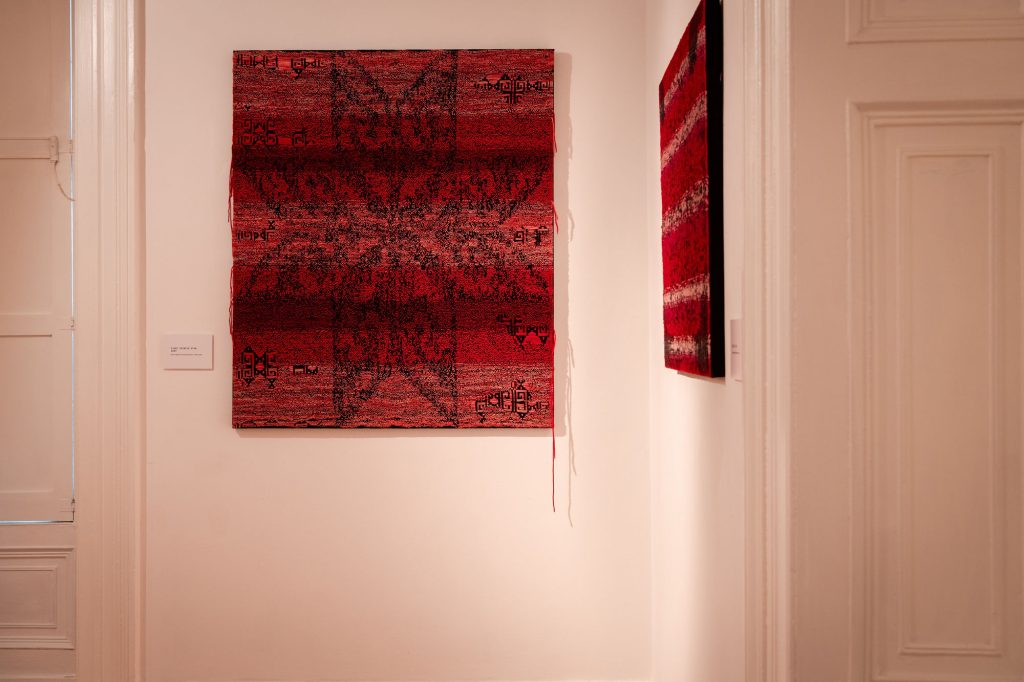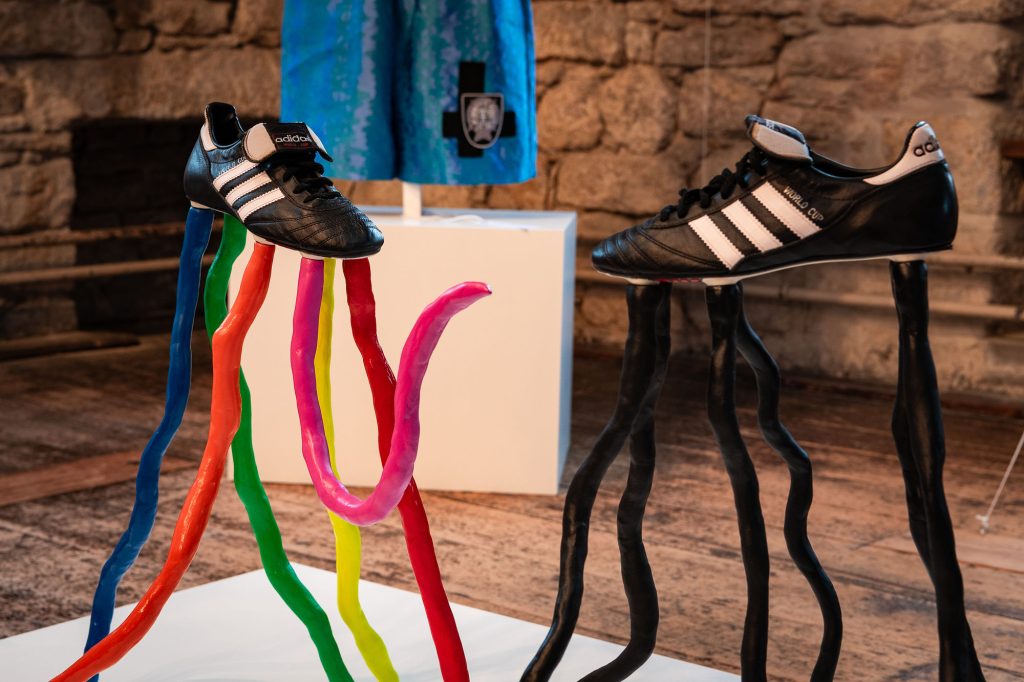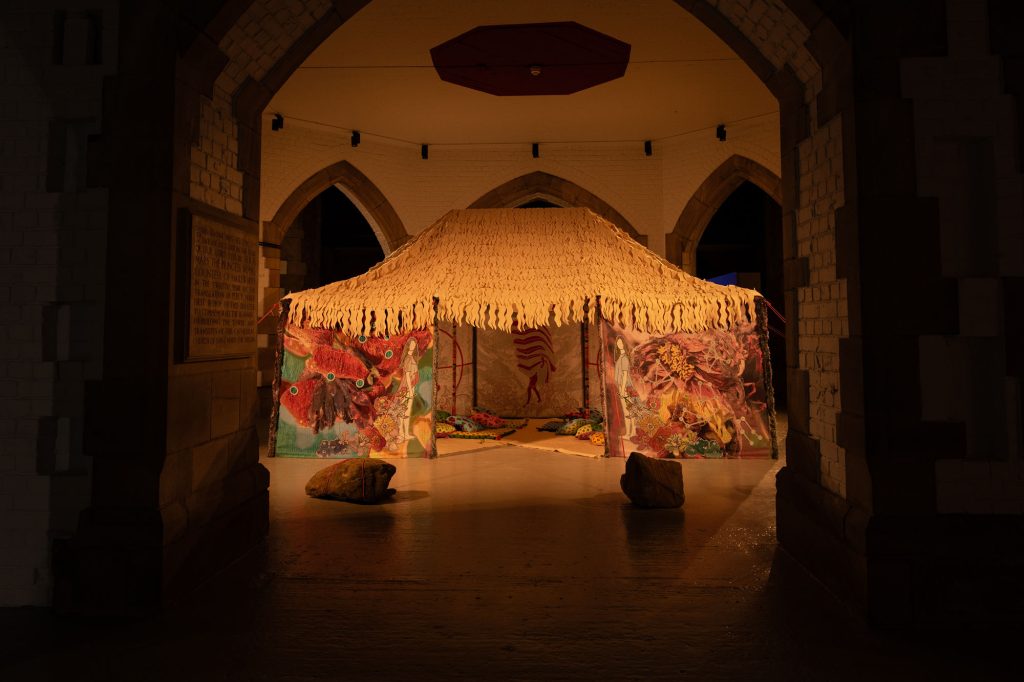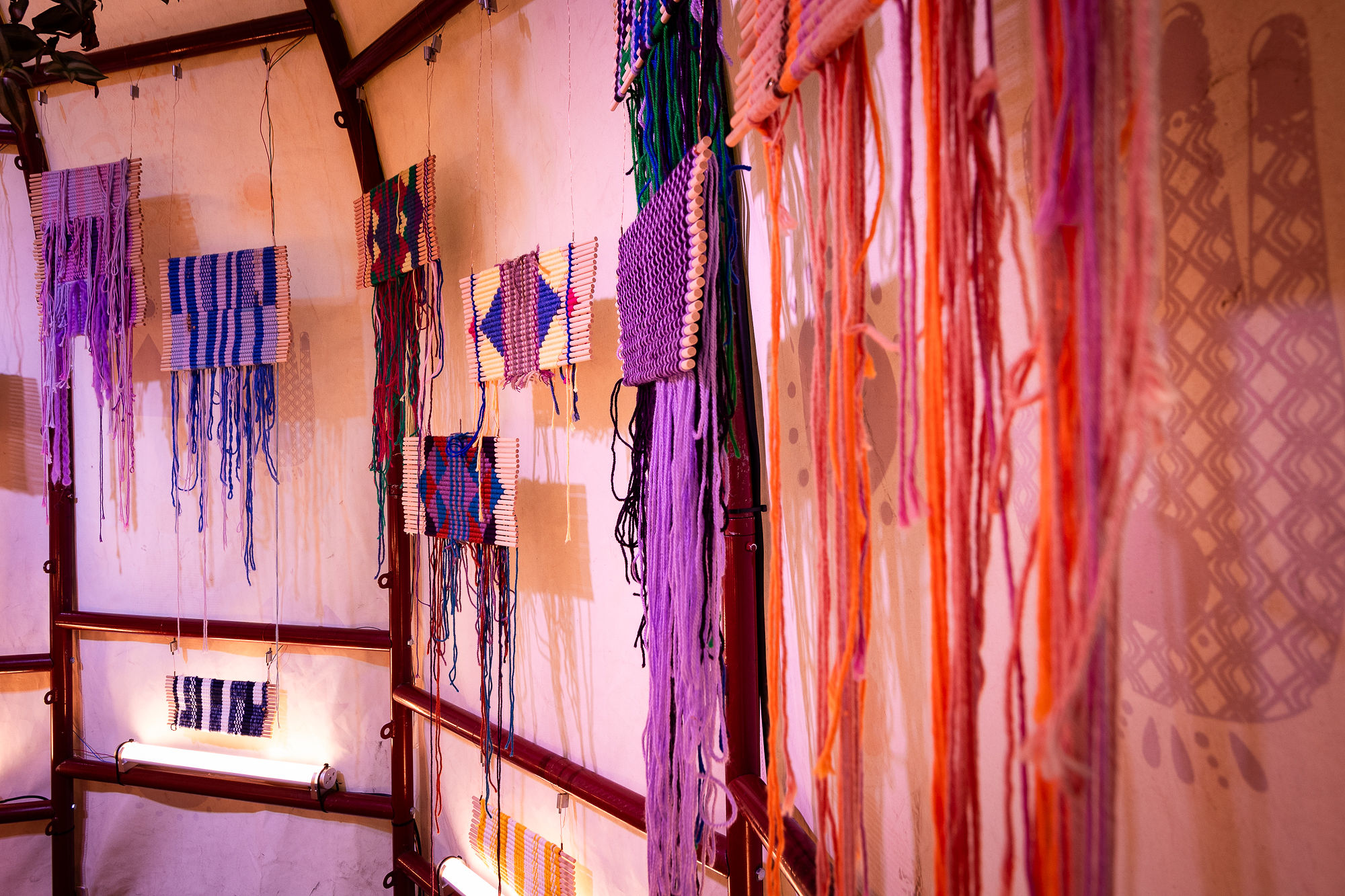Stitches on stitches, roses within stars: I gaze towards densely woven yarns, impassioned reds, blues, blacks, a pattern inside a pattern. Up close, the irregularities in the weave structure look like a glitching screen, destabilising what at first appears to be a consistent pattern. A weaving of ruptures and multitudes, drawing on the analog and the digital, the human and the non-human, the earthly and the celestial, the past and the present, to consider how these elements might connect and intersect through textiles.
The artwork ahead of me is ‘Rose Star’ (2024) by Sarah Rosalena, an artist based in Los Angeles. Her cosmically-inspired textiles draw on the traditions of her matrilineal descent from indigenous Wixárika women weavers. Blending technology with the handmade, she uses hand-dyed cochineal wool and cotton yarn to hand-weave on a digital Jacquard Loom (a pattern is uploaded, setting each warp thread to be raised or lowered as she weaves the weft thread manually). By this process, Rosalena populates her surface with woven motifs of stars and roses. The wall text explains that, could we see it, these patterns resemble each other from the reverse and fit into each other, side by side, infinitely, making an abstracted tapestry that could appear to depict a deep space or a flat plane. It could resemble a microscopic cross-section of a stone or plant as much as it could resemble a vast terrain or the floor of the ocean viewed from above. Through these themes of transformation and adaptability, Rosalena makes clear the expanse of the medium in its potential to materially reflect these dualities.
In the British Textile Biennial 2025, ‘Rose Star’ by Rosalena is featured in Learning from the Land at the Whitaker Museum & Art Gallery, along with two of her other works, ‘Red Shift Spiral’ (2024) and ‘Eight Pointed Star’ (2023). This exhibition brings together six artists whose work considers the teachings of the natural world and humanity’s impact on it. Zapotec-American artist Porfirio Gutiérrez and Mexican artist Tania Candiani also use cochineal dye in their work to examine the colonial exploitation of Indigenous communities and cultures. Bengaluru artist Dhara Mehrotra’s installation ‘Filmaentous’ (2025) celebrates mycelium’s potential as a sustainable material through its vast, microscopic networks, which are magnified and represented by a dense architectural web of golden threads, scaling the walls of the room. Melanie Smith and Patricio Villarreal’s film ‘Tixinda’ (2025) documents the seasonal traditions of the Mixtec community in Oaxaca, in which they gather purple dye from a now fast-declining population of sea snails. Knowledge of this tradition is in decline too, and the film documents and raises awareness of the importance of this ancient land-based knowledge. Each artist puts emphasis on reviving a reciprocal relationship between people and the land rather than an exploitative one, drawing on traditional textile techniques and ancestral knowledge to consider how we might work with the earth, not against it.

British Textile Biennial explores Lancashire’s formative role in the global textiles industry through contemporary art, design and textiles, from the nascent cotton industry to the development of synthetic fibres that boomed in the mid-twentieth century. The historic venues, set against the moors of rural Lancashire, include textile mills, museums, galleries, theatres and cathedrals. At the time of the festival, the season is turning and the hills are a deep, damp green, doused in the same moist air that kept yarn soft for spinning in the Industrial Revolution. This was crucial to the success of textiles production here, along with the abundant availability of coal, and the canal network, which was essential to transporting goods.
The expansive scope of textiles as a material of artistic, domestic and commercial function is clear to see in the Biennial’s vast programme. Where previous iterations of the festival focused on contemporary art, the programme this year gives equal weight to design and heritage. Delving into invention and innovation in textile production past and present, we follow a web of local and global, complex and interconnected stories of fibre and cloth through the region, mediated by the urgent need to acknowledge or repair the damages and re-negotiate the future of textile production. This balance is clear to see in the heritage-led exhibitions such as The Synthetic Revolution at Haworth Art Gallery in Accrington, charting the mid-twentieth century’s rapid boom then decline in the popularity of synthetic fibres. Terelyne was the first synthetic fibre, invented in Accrington in 1941. Derived from fossil fuels, it was mass-produced and marketed mainly to women, whose domestic chores would be eased by the fabric’s durability and easy-care properties. The collaborative curation of artist and academic Claire Wellesley-Smith and fashion historian and broadcaster Amber Butchart succinctly tracks the origins, history and cultural context of synthetic fibres and how their use led the industry towards disastrous environmental impacts. (Synthetics are again popular in fast fashion and majorly contributing to the ecological crisis in which 85% of our clothes end up in landfills or are incinerated.)
Pioneers of the Material World at Towneley Hall art gallery and museum in Burnley is presented in collaboration with Max Leonard, writer and creative director of Isola Press, and Henry Iddon, author and photographer whose book Mountain Style: British Outdoor Clothing 1953 – 2000 was published last year. Clothing from across a century is displayed alongside historical artefacts and photographs, charting the stories of Lancashire’s role in high-performance clothing. Displaying a great span of stories, this exhibition unearths the deep threads of cultural influence that textiles have on many different communities. Its non-commercial presentation speaks to the relational potential of textiles as a medium that can have deep connections to all our lives, through our bodies, our memories, our identities, our cultures, our environments. It is a democratic medium, and one integral to our relationship with the land.
At Turton Tower near Blackburn, three exhibitions deepen this line of enquiry, examining sports histories through material and memory. Christian Jeffrey’s ‘Comfort Ye One Another’ (2025) is a floral, hand-painted, 100% silk football shirt, exquisite in its detail and precision, celebrating the role of Turton Tower in both textiles and football histories. What at first seems a tangential connection to football actually comes from a coincidental family history: James Kay, who came to own Turton Tower in 1835, invented the wet spinning process for flax which enabled the process to be industrialised, and his family also had huge influence on the formation of Turton FC, and on Lancashire Football more widely in the 1870’s. åbäke & Le Cercle du S226erpent Bleu’s exhibition RROOUUBBAAIIXX 2033 blurs real and fictional stories of football rivalry-turned collective action, using weaving and storytelling to provide alternative reflections on textiles as a medium that connects cross-generationally and culturally. 100% UNOFFICIAL: The Fabric of Fandom turns the tower into an expanded wardrobe of football supporters’ textile endeavours. It is an ode to the medium as a vehicle of expression and community, featuring items from the National Football Museum and Westminster Menswear Archive, as well as garments made by over thirty artists and designers.

In Queen Street Mill, the last surviving nineteenth-century steam-powered weaving mill in the world, 300 looms stretch out, filling a vast space. Artists Tim Smith, Crystal Bennes and Sarah Rosalena have work installed throughout the building. As part of Smith’s site-wide installation, ‘Weaving the Future’ (2019), photographs are printed on woven textiles and suspended over the looms, visually narrating stages of the industrial processes at textile mills. In a smaller room off the main weaving shed, Smith’s installation continues with a film projected onto translucent fabric. It depicts repetitions in various forms: in the movements of people in abstract visual patterns, in the rhythmic sounds of weaving machinery, in the gridded layout of the looms. When layered together, these repetitions evoke not only the weaving process but stories of the monotonous and laborious experience of working in the mills, making close links to the industry as a whole, with all its light and shade, its inherent duality.
In another room in the mill, this light and shade is further examined in Crystal Bennes’ installation ‘When Computers Were Women’ (2021), which speaks to the devaluing of women’s work and the erasure of their participation in documented histories through ‘labour-saving’ technologies such as mechanised looms. Bennes developed this artwork after a residency with CERN (the European Organization for Nuclear Research), where she found a computer programme for a physics experiment stored on 2,131 computer punchcards, in sequential order. Interested in this data that had been deemed important enough to save but not to put in CERN’s archive and struck by the resemblance they had to loom punchcards, Bennes worked with a team of women weavers at Dash & Miller in Bristol to translate them and use them to programme a Jacquard loom. The four resulting weavings, seventy centimetres wide and three metres long (from 2,131 lines of weft), are draped over metal bars, stark grey and white, dappled with a loose hair-like weft. Bennes refers to them herself as ‘technically terrible’ – they were designed as literal translations of information rather than perfect weave structures or beautiful designs. I do, despite or perhaps because of these technical imperfections, think they are beautiful. There’s a softness to their loose weave and monochromatic, irregular pattern, and the space between them and the cold walls of the room is vacuous. It presents an emptiness that speaks to the remnants of the women’s work that lies, erased, somewhere between the two. As much a celebration of textiles as an instrument of innovation and connection, the Biennial here makes honest investigations into the industry’s often-opaque histories.
Across the Biennial, it is the artists engaging with these materials in haptic, experimental and symbolic ways that I found the most captivating. This includes Ivan Forde’s installation Eternal Seas (2025) at Haworth Art Gallery, comprising three cyanotype and mixed-media prints. Deep blues and greens depict real and dreamlike bodies of water on large fabrics, suspended between the stone archways of the gallery’s Billiard Room. This fabric was provided by Forde’s collaborators Bionic Yarn, a pioneering textile company based in Costa Rica who work with remote coastal communities to recover plastics from the ocean or intercept plastic waste before it gets there, repurposing it into durable, high-performance textiles. Laced with visual and material narratives, Eternal Seas takes us into fictional spaces whilst transfixing us, facing us with the reality of industrial textiles production on the land and ocean. Alexis Maxwell’s immersive installation ‘Memory Fabric’ (2025) at the Technology Centre in Nelson uses sound, projection and animation to depict an imagined fabric, exploring collective memory and how a place is shaped by its community. At the Pendle Heritage Centre, artist Anna Clough’s outdoor sculpture ‘Fold Anew’ (2025), made of soil, sand, water, hay and wool, is materially and symbolically rich, observing how we might harness traditional and nature-based methods of production to forge a more sustainable future. At Blakey Moor in Blackburn, The Dhaqan Collective’s immersive and participatory soundscape ‘The Aqal (House of Weaving Songs)’ (2025) is inspired by Somalian weaving traditions and songs, passed down through generations and held inside the aqal, a round hut structure woven with natural materials.

Lucy and Jorge Orta’s immense retrospective Homo Mondialis at Blackburn Cathedral Crypt brings together the Biennial’s web of ideas in craft, sculpture, video and poetry. The walkthrough installation of thirty artworks is a speculative response to the scenario of mass desertification, moving through geographic zones and cultures to consider ways of nomadic living. ‘House of Hair’ (2025), Lucy Orta’s sculptural interpretation of the traditional Bedouin tent, a nomadic Arab structure typically woven with camel and goat hair, is central to the exhibition. The tapestry dwelling has seven intricately detailed walls and an opening on one side, inviting us in. Embroidered fabrics, applique images and metallic threads cover every surface, illustrating speculative and symbolic figures, animals and hands. The sides are bordered by thick fringe trimmings and every corner is bound to a large stone with red cord. Orbiting this work are large-scale video installations and eerie sculptural figures, vivid panels of plant specimens, magnified and rendered in fabric, adorned with glass beads, buttons and cords. Homo Mondialis anchors the Biennial, bringing together its deep considerations of nature and earth-centred traditional crafts, paired with the urge to honour and use this knowledge to create a more sustainable future. A future in which we learn and grow in harmony with the land and the cultures around us. Textiles is a language that relates as much to the individual as to the collective, and just as much to the earth.
The British Textile Biennial’s venues are non-commercial and often integral to the histories told in their exhibitions. The inherited and felt memories of these locations reflect the inherited histories and haptics of cloth, as materials for communication and connection – as a democratic engine for thinking past and present, cross-generationally and cross-culturally. The Biennial feels like a patchwork quilt and at every seam I am reminded of the ways that textiles and its stories are entwined into our bodies and homes, our cultures and families, our past and present and always our future. For that is where this year’s festival is firmly rooted, or headed, shall I say: the future.
British Textile Biennial, Lancashire, 2 October – 2 November 2025.
The Whitaker exhibition continues until 23 November 2025, Haworth Art Gallery exhibitions continue until 19 December 2025, and Towneley Hall exhibition continues until 21 December 2025.
Sally Button is a writer and artist living in Lancaster.
This review is supported by British Textile Biennial.
Published 24.10.2025 by Jazmine Linklater in Reviews
2,286 words





